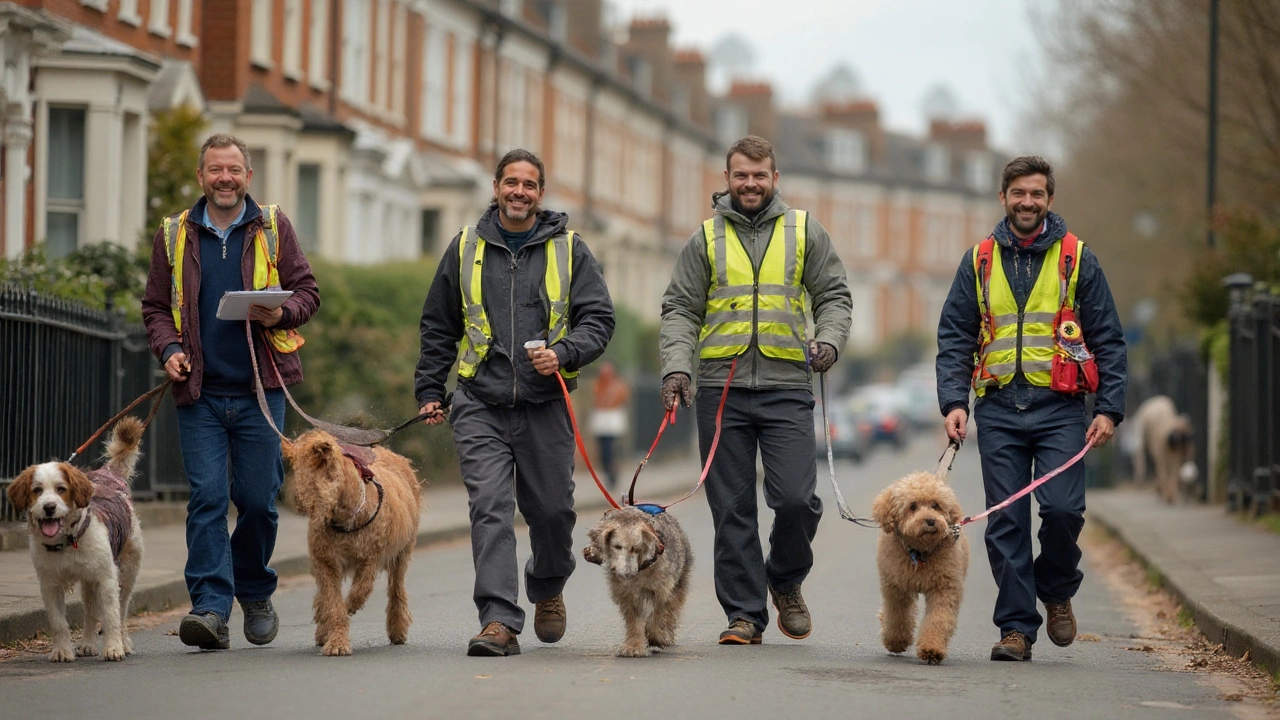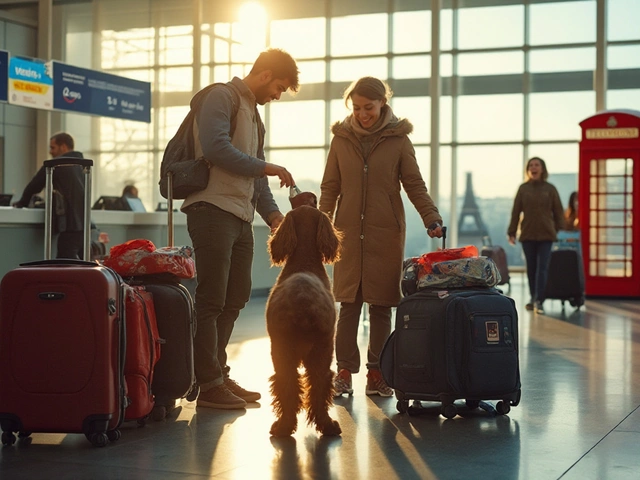Be honest—your feed is full of people making cash while getting their steps in and hanging out with happy dogs. It’s the gig everyone’s talking about: starting a dog walking business. The appeal is obvious. You set your own hours, have an excuse to be outside, and literally get paid to hang out with adorable pups. But is starting a dog walking business as dreamy as it looks? Or is it all muddy shoes, unpredictable pay, and soggy tennis balls? Let's pull back the curtain and get real about what’s great, what’s tough, and what actually works when you start walking dogs for money.
The Real Demand for Dog Walking: Why Are People Paying?
It’s wild how much money people spend just to keep their pets happy. Dogs aren’t just animals, they're family, and that means their care isn’t something owners take lightly. The numbers? Americans spent over $147 billion on pets in 2024, and a chunk of that went right into pet services like dog walking. Two big reasons drive this: long work hours and a post-pandemic love for dogs. Remote work didn’t last as long as everyone hoped, so now tons of dogs are home alone, and their owners feel guilty about it. So they pay people like you to keep their pups moving, socialized, and, quite frankly, sane.
You might think tech would take this job away. But apps like Rover and Wag! only make dog walking more visible. They’ve helped turn it from a favor-for-a-friend into a real, paid profession. It’s not just big cities, either. Suburban and even rural areas are seeing higher demand for reliable dog walkers, especially families with busy schedules or older people who need extra help. Ultimately, if you live anywhere with people who own dogs—and that’s just about everywhere—there’s likely a neighborhood or three full of dogs needing exercise while their people clock in long hours.
The big takeaway? Dog walking isn’t a side hustle for broke teens or retirees anymore. It’s an actual, in-demand service that pays real bills. In fact, according to Pet Sitters International's 2025 survey, 67% of professional pet care providers said they’d seen an increase in demand last year—especially in dog walking.
How Much Money Can You Actually Make?
Here’s where things get interesting. People always want that dollar figure, right? What do you really earn with a leash in your hand? The answer: it depends on your area, how many dogs you walk at once, if you work for yourself or through an app, and—let’s be real—how much hustle you put in.
In New York City or San Francisco, rates hover around $25–$35 for a 30-minute walk per dog. Step out into smaller towns, and rates might drop to $15–$20, but loyal clients make up for it. Walk two or three dogs at the same time? That’s where the money grows without adding much extra effort. According to data from TimeToPet (a popular pet care management tool), full-time dog walkers can hit $30,000 to $50,000 per year, and that’s after taking out expenses.
But expenses matter. Think insurance, gas, treats, doggy bags, and sometimes taxes if you’re self-employed. Here’s a simple breakdown so you can see how it works out:
| Service | Typical Fee (30 mins, 1 dog) | High Cost Cities | Low/Mid Cost Areas |
|---|---|---|---|
| Walking Solo | $20–$35 | $30–$35 | $15–$20 |
| Group Walk (2 Dogs) | $30–$50 | $40–$50 | $25–$35 |
| Monthly Package (20 walks) | $350–$650 | $550–$650 | $350–$450 |
If you walk 4 dogs a day for 5 days a week at $25 a walk, you’d bring in around $2,000 every month—before expenses. Scale up or group walk, and the numbers climb. Some walkers double that by adding in pet sitting or boarding, especially during school breaks and major holidays.
Apps like Rover or Wag! make finding clients easier but keep up to 20% of your fee. Experienced walkers often go independent once they’ve built trust and consistent referrals. That’s when things really get profitable.

What It Takes: Skills, Tools, and Startup Steps
Walking a dog isn’t rocket science, but successful dog walkers have a mix of practical skills, business sense, and genuine love for animals. Step one: know your dog breeds and basic dog behavior. You’ll meet everything from gentle goldens to anxious rescues and wild terriers. Knowing how to read dog body language keeps everyone safe (including you). Certified Pet First Aid classes are worth it. They look good to clients, and honestly, you don’t want to Google “what to do if a dog cuts its paw” in the middle of a walk.
Timing and organization are key. You need a phone calendar packed with addresses and notes about which dog gets nervous in the rain, who chases squirrels, and which owner insists on only biodegradable bags (#guilty). Communication wins loyalty. A quick update and a happy photo or two after every walk mean owners trust you—and trust leads to tips and referrals.
Gear? Keep it simple and practical. Here’s what you actually need, not just what Instagram says you need:
- Sturdy leashes (adjustable lengths are best)
- Poo bags (lots—you’ll go through them faster than you think)
- Basic first aid kit (bandages, tweezers, antiseptic wipes)
- Treat pouch (keeps your hands free for, well, dogs)
- Portable water bowl (hot days will sneak up on you)
- Comfortable shoes (trust me, sneakers not flats)
Insurance matters, too. Pet liability insurance is pretty cheap for peace of mind and some clients will only hire insured walkers. If you’re walking more than one dog at a time, look into what your local laws require for group walks, and always check leash laws and off-leash rules. One unexpected dog chase can turn a fun stroll into a viral disaster (just ask my daughter Elsie, who filmed me sprinting after a beagle last spring—yes, it’s still on her phone for bribery purposes).
Ready to start? Here are the steps I’d suggest:
- Start with friends or neighbors’ dogs to get experience.
- Build simple profiles on pet care apps and use clear, friendly photos.
- Invest in insurance and basic gear.
- Ask for reviews and referrals after every walk—it matters!
- Keep track of bookings and payments. Apps can help, but old-fashioned spreadsheets work too.
- Set clear cancellation/sick pet policies upfront. Trust me, day-after-party “emergencies” are a thing.
Bumps in the Road: Challenges and Lessons Learned
Dog walking is not just fresh air and wagging tails—any seasoned walker will tell you that. First off, the weather rarely cooperates. You’ll find yourself marching through rain, mud, snow, and summer heat waves, and there’s no “rain day” in this gig. Dogs need their walks no matter what’s on the forecast, so having rain gear and tough lungs is a must.
Another challenge? Dogs come with their own personalities and issues. Anxious rescue pups might freeze and refuse to move. Some dogs lunge at every passing squirrel and drag you like a sled. Puppies chew through leashes, and older dogs need patience, not speed. Reading canine behavior fast—and responding calmly—makes the difference between a smooth walk and chaos. Once, I spent 15 minutes persuading a soggy bulldog to cross the street because he simply wouldn’t step in a puddle. You're part dog psychologist, part athlete.
There are also people. Overprotective owners text mid-walk (“Is Sparky drinking water?”). Neighbors question why you're on their block. Some pet parents are lovely, others can be picky—so thick skin helps. The worst part? Unstable incomes. Spring and autumn mean booming business, then winter holidays hit or school’s out, and bookings can drop without notice. Building a large client base smooths things out. Offering extra services (like pet-sitting or bringing in mail while people vacation) is a smart backup for lean seasons.
Pitfalls worth mentioning: Under-insured? One dog bite could wipe your earnings. Not setting cancellation fees or policies? People cancel last minute—often—with no warning. Equipment fails (leashes snap, treats run out… sometimes both). Reliable backup is gold. Keep numbers for friends or trusted local walkers who can fill in during emergencies. The truth is, you’ll earn lessons the hard way. My first summer, I scheduled back-to-back walks with no travel time between, ending up sprinting sweaty blocks with leashes tangled in my wrist. You laugh, you learn, you get smarter—and your clients will mention your hustle in reviews.

Growth, Perks, & What Successful Dog Walkers Do Differently
Now for the real gold: the perks and growth potential that make people stick with dog walking long term. First, the healthy lifestyle is underrated. I swapped out a desk job for walking dogs, and suddenly I was hitting 25,000 steps a day and sleeping better at night. No gym membership needed. Plus, the regular movement is great for your mental health. Studies from the Human-Animal Bond Research Institute show even short walks with dogs lower stress and boost mood.
Social connections are the hidden bonus. You’ll meet neighbors, make friends, and get plugged into your community through clients, dog parks, and fellow walkers. Those relationships turn into referrals—half of my regular clients came from conversations at the playground or chatting with other dog parents in my neighborhood. If you enjoy people as much as dogs, you’ll build a loyal tribe that supports your business and gives tips for tough breeds and tricky weather days.
Successful walkers do a few things differently. They’re never late and never drop the ball on communication. They keep learning—dog behavior, breed quirks, even canine CPR. They know when to say no (a dog too reactive, mismatched schedules, or tricky logistics). Add-on services like “puppy check-ins,” holiday pet sitting, or even doggy taxi rides to the vet can double your income. Some walkers grow into small businesses with part-time helpers or even boarding facilities. Others keep it solo and simple, making enough to cover bills and enjoy an active lifestyle.
The best tip? Treat it like a real business, not just an easy side gig. That means planning routes, tracking expenses, saving for slow months, and always showing up with a smile and plenty of poop bags. The work is honest, messy, rewarding, and never boring. People notice when you care for their dogs like your own. A dog walking business isn’t a ticket to instant riches, but if you’re ready for unpredictable weather, wiggly leashes, and real-life connections, it can be more fulfilling than you ever imagined.





